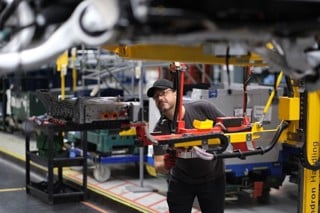Clive Buhagiar, head of public sector at Alphabet, is warning a substantial number of public sector organisations still do not have plans in place to meet the change in European Community Whole Vehicle Type Approval (ECWVTA) regulations for light commercial vehicles (category N1) which come into force on 29th April, 2013. The update to the legislation will mean purchasers, funders and operators of vehicles will be liable to penalties, including fines and imprisonment, if the manufacturer and bodywork builder have not gained the appropriate approval for the individual components and any conversion work.
Buhagiar comments: “There are more than 1.6 million LCVs on Britain’s roads and a large number of those are leased or owned by the public sector. From parks vehicles within local authorities to facilities management vans run by housing associations, LCVs used for logistics and transport in the NHS to general purpose vehicles in the charity sector, the potential number of organisations affected by the ECWVTA changes is significant. However, despite the positive work being done by the SMMT and BVRLA, awareness levels about the true impact of the changes has remained relatively low in the public sector.”
He continues: “The big change with these regulations is the fact that conversions now have to be Type Approved, separately to the build of the original manufacturer vehicle. But, when you say conversion to people, they immediately think big – a whole new body on an existing chassis for example. In this case, however, conversion could be as little as adding a tow bar, fixed light bar or any electrical fitments – changes which are requested every day by public sector customers. Indeed, because of its strong commitment to duty of care and the wellbeing of its employees, organisations in the public sector can be some of the most specific when it comes to determining bespoke requirements for particular vehicles.”
The ECWVTA process ensures vehicles meet the relevant environmental, safety and security standards. Because it is not practical to test every vehicle made, one production vehicle is tested to be representative of the ‘type’. Once a vehicle is approved, the manufacturer (or converter) can produce a Certificate of Conformity for each subsequent vehicle of that type.
Buhagiar adds: “There are a number of areas which public sector fleet managers need to address. Firstly, the legislation is now only a matter of weeks away. While existing vehicles on the fleet are exempt, any upcoming purchases or renewals will need to comply with the new scheme. It could take at least six weeks to get a conversion through the Type Approval process so it is vital to think ahead in order to avoid any delays to front line public services.
“Assessing the fleet as a whole, it may be possible to streamline the number of different conversions being used. Where bespoke vans may currently exist for each department, it may be possible to use the same type of conversion across the wider fleet going forward – whether a tailored or off-the-shelf solution. As well as reducing the cost and time burden associated with acquiring the vehicles, this can also help to create a more flexible fleet, with vans which can multi-task and deliver greater efficiencies.
“Ultimately, the public sector should welcome the ECWVTA changes because of the impact on improving quality and environmental performance within the conversions sector. Whether owned or leased vehicles, it is important to manage the process effectively, opening the lines of communication with the conversion workshops and investing time in conducting a full needs audit of the entire fleet. A proactive approach now could save significant time and money further down the line. A logical next step would be for public sector organisations with similar requirements to agree standard conversions that would be mutually suitable; this would drive economies of scale to reduce cost and ultimately speed up conversion timescales.”



















Panic Station? - 28/02/2013 15:49
Not all of the information in this article is correct. Many small enhancements will be covered under the COMPLETE’ VEHICLE ENHANCEMENT SCHEME – CATEGORY N1 AND N2 VANS. This covers a multitude of small enhancements like ply lining, racking etc. All of the items covered in it will not be subject to WVTA, therefore a fair amount of ado about nothing in this artcle TO AN EXTENT.